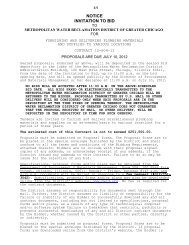Report - Metropolitan Water Reclamation District of Greater Chicago
Report - Metropolitan Water Reclamation District of Greater Chicago
Report - Metropolitan Water Reclamation District of Greater Chicago
Create successful ePaper yourself
Turn your PDF publications into a flip-book with our unique Google optimized e-Paper software.
those WRPs. In fact, the study estimated that the gastrointestinal illness risk associated with<br />
incidental contact recreational on the CAWS was minimal, and is below the USEP A threshold<br />
for primary contact recreation 1. The findings from this study have been peer reviewed and<br />
published 2 ,3. The study received recognition as a scholarly research work and in 2010 was<br />
awarded the American Academy <strong>of</strong> Environmental Engineers Excellence in Environmental<br />
Engineering Research Honor Award (http://www.aaee.net/Website/E320 1 OHonor<br />
Research.htm) .<br />
Epidemiological Research Study <strong>of</strong> Recreational Use <strong>of</strong> the <strong>Chicago</strong> Area <strong>Water</strong>way<br />
System. The study known as the <strong>Chicago</strong> Health, Environmental Exposure and Recreation Study<br />
(CHEERS), conducted in collaboration with a multidisciplinary team at the University <strong>of</strong> Illinois<br />
at <strong>Chicago</strong> (UIC) School <strong>of</strong> Public Health, was completed and the final report was submitted to<br />
IPCB. The CHEERS directly measured the occurrence <strong>of</strong> illness associated with incidental<br />
contact recreation between the study groups -- CAWS, general use water (GUW), and<br />
unexposed. The CHEERS report concluded that rates <strong>of</strong> gastrointestinal illness are not higher<br />
among CAWS recreators when compared to recreators participating in the same activities on<br />
GUW (area rivers, inland lakes, or Lake Michigan) that do not receive undisinfected wastewater<br />
effluent.<br />
<strong>Water</strong> <strong>Reclamation</strong> Plant Operation Monitoring and Research. The AMBS<br />
conducted analysis and provided technical counsel for the following: (1) monitoring for fecal<br />
coliform (FC) and E. coli (EC) to evaluate ultraviolet light disinfection systems; (2) monitoring<br />
microbial densities on farm soil after application <strong>of</strong> biosolids; (3) studying effective disinfection<br />
strategies for high-flow Egan WRP; and (4) assessing microbiological health <strong>of</strong> mixed liquor to<br />
solve operational problems at Egan, North Side, and Calumet WRPs.<br />
Specialized Laboratories Monitoring and Research. The Section's four state-<strong>of</strong>-theart<br />
laboratories performed a wide range <strong>of</strong> microbiological analyses in the areas <strong>of</strong> bacteriology,<br />
environmental microbiology, parasitology, virology, and biomonitoring. Construction was<br />
Geosyntec, 2008.Dry. and Wet Weather Risk Assessment <strong>of</strong> Human Health Impacts <strong>of</strong><br />
Disinfection vs. No Disinfection <strong>of</strong> the <strong>Chicago</strong> Area <strong>Water</strong>ways System, <strong>District</strong> website<br />
( www.mwrd.org).<br />
2 G. Rijal et al. 2009. Dry and wet weather microbial characterization <strong>of</strong> the <strong>Chicago</strong> area<br />
waterway system. <strong>Water</strong> Science & Technology-WST, Vol. 60 No.7 pp. 1847-1855© IWA<br />
Publishing 2009 doi:10.2166/wst.2009.598.<br />
3 G. Rijal et al. 2010. Microbial Risk Assessment for Recreational Use <strong>of</strong> the <strong>Chicago</strong> Area<br />
<strong>Water</strong>way System. Journal <strong>of</strong> <strong>Water</strong> and Health © IW A Accepted for Publication currently in<br />
press.<br />
30
















